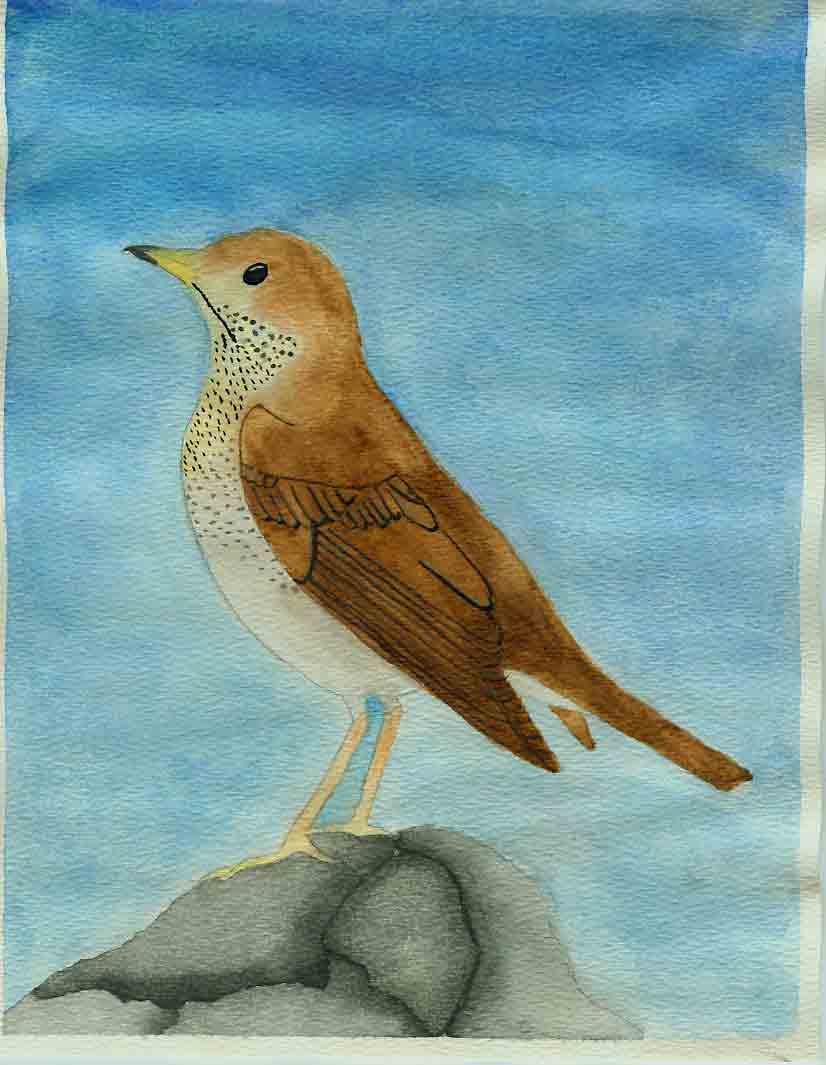
July 26, 2008

Bicknell’s thrush, Catharus bicknelli. Drawing by Liza.

Veery, Catharus fuscescens. Drawing by Whatbird.
The Vermont Center Of Ecostudies (VCE) files a new report, which could have implications for other studies of hybrids in high-elevation bird populations:
The recent discovery atop Stratton Mountain (Vermont) of an apparent hybrid of a Bicknell’s thrush and veery, two closely related species in the genus Catharus, has generated some buzz in birding circles.
The bird was discovered by field biologists with the Vermont Center for Ecostudies (VCE) in the course of their long-term research on high-elevation bird populations. The first clue to this individual’s possible hybrid origin was provided by its song, which combined elements of Bicknell’s thrush and veery. In-hand examination following a mist net capture revealed that the bird (a male) had plumage characters of both species, though it appeared more veery-like overall.
VCE collected small amounts of blood and feathers, which will be subjected to mitochondrial DNA analysis to document the bird’s maternal roots. This will provide insight (although not conclusive proof) into whether its parents crossed species boundaries and mated. It seems likely that the father was a veery, the mother, a Bicknell’s Thrush. This would help explain the bird’s song, which was predominantly that of a veery (young birds learn songs in part by imprinting while in the nest).
Assuming the bird is a hybrid, the question naturally arises as to how these individuals of two ecologically separate species found one another. Bicknell’s thrush is specialized on fir-spruce forests that grow only on mountaintops above 3,000 feet in Vermont. Veery is a species of lowland hardwood forests, primarily second growth and flood plain. Does occupancy of mountaintop forests by a veery signal the upslope creep of deciduous forests due to climate change, as has been shown by recent University of Vermont research? Possibly, but it is far too early to make that case.
The most reasonable explanation for this presumed hybrid mating is one of serendipity. Birds are mobile creatures, and these two species are, after all, closely related, with similar plumage and vocalizations. Blue- and golden-winged warblers provide a familiar example of two species that regularly interbreed and produce offspring that themselves might be fertile. Most avian hybrids, however, show reduced or no fertility, such that hybridization is rarely significant in a biological or evolutionary sense. In the case of the Stratton “thrush,” it is best viewed as a scientific curiosity for now.
Source: “Bird Brains: Hybrid-bird sighting ruffles feathers” by Chris Rimmer, Burlington Press, July 25, 2008.
The rarely seen Vermont resident, the Bicknell’s thrush.
About Loren Coleman
Loren Coleman is one of the world’s leading cryptozoologists, some say “the” leading living cryptozoologist. Certainly, he is acknowledged as the current living American researcher and writer who has most popularized cryptozoology in the late 20th and early 21st centuries.
Starting his fieldwork and investigations in 1960, after traveling and trekking extensively in pursuit of cryptozoological mysteries, Coleman began writing to share his experiences in 1969. An honorary member of Ivan T. Sanderson’s Society for the Investigation of the Unexplained in the 1970s, Coleman has been bestowed with similar honorary memberships of the North Idaho College Cryptozoology Club in 1983, and in subsequent years, that of the British Columbia Scientific Cryptozoology Club, CryptoSafari International, and other international organizations. He was also a Life Member and Benefactor of the International Society of Cryptozoology (now-defunct).
Loren Coleman’s daily blog, as a member of the Cryptomundo Team, served as an ongoing avenue of communication for the ever-growing body of cryptozoo news from 2005 through 2013. He returned as an infrequent contributor beginning Halloween week of 2015.
Coleman is the founder in 2003, and current director of the International Cryptozoology Museum in Portland, Maine.
Filed under Breaking News, Cryptotourism, CryptoZoo News, Cryptozoologists, Cryptozoology, Eyewitness Accounts, Forensic Science, New Species, Winged Weirdies